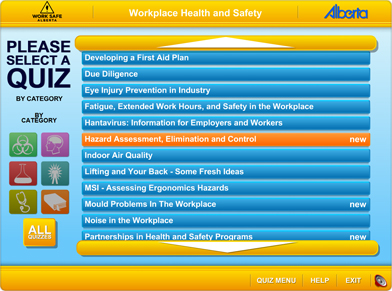Training Room 2: Hazard Identification, Assessment and Control
Employers are required to instruct all workers who work with or are in the proximity of controlled products (hazardous materials) in the safety regulations that apply to working with controlled products. You may or may not initially be working with or close to controlled products, but it is important for you to know about them so that you can determine the procedures for working safely with many controlled products with which you may come into contact.
Objectives
Once you are done this section, you will be able to:
- identify the five major categories of hazards using specific examples from a variety of work environments
- describe common jobsite hazard identification processes
- explain and correctly use terminology related to hazard identification, assessment and control
- define health and the purpose of Occupational Health
- create a safety plan that includes prevention, identification, response and communication
- identify and describe safe and unsafe working conditions
Lesson 1: Types of Hazards
There are five major categories of hazards. Click here to view an interactivity that will teach you more about these categories.
Try this!
Can you think of an example of each of the 5 types of hazards either from your home or school environment?
Share your thoughts with a friend, family member or classmate.
Now try this game to see how much you learned.
Hazard vs Risk
What is the difference between a hazard and a risk?
Did you know?
Workers with less than six months experience are three times more likely to be injured than those with a year or more of experience?
Workers under the age of 25 are 33% more likely to be injured on the job than older workers?
There are several possible reasons:
- lack of knowledge
- lack of skill
- lack of experience
- trust that their supervisor will look after them (won't let them do anything dangerous)
- desire to impress their supervisor
- fear of asking questions and/or appearing stupid
- more of a risk taking approach
Just the Facts presents the Top Dangers for Young Workers.
Here are 10 questions you should ask an employer about hazards and safety. If this link doesn't work, click here.
Emergency Response Plan
A serious emergency (such as an explosion, fire, or flood) could seriously affect the operation of a business and put the health, safety, and livelihood of many employees in jeopardy.
To prepare for an emergency, an employer should:
- Identify potential emergencies. This includes workplace hazards as well as hazards which may be introduced onto the work site by one of the following
sources:
• natural disasters
• man-made events
• technological failures - Develop evacuation procedures.
- Create a communication plan.
- Train employees in procedure to follow during an emergency.
- Obtain, identify and maintain emergency equipment.
- Access resources such as disaster services.
Health and Safety at School
This interactivity will help you understand workplace health and safety at school.
Complete the activity, including the Check your Understanding quiz.

